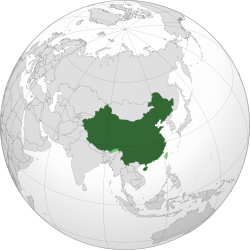China nopo nga ointutunan miampai ngaran totopot nopo nga Republik Rakyat China, iso pogun id Asia Timur ii kiwaa tongoulun i ogumu id sompomogunan miampai lobi do 1300 juta tulun, om iso perlimo tulun nopo nga id pomogunan. China nopo nga noporinta do Parti Komunis China id siriba sistom iso parti, om kigana kuasa do 22 wilayah (provinsi), limo koiyonon kiautonomi, apat perbandaran tadbiran potilombus (Beijing, Tianjin, Shanghai, om Chongqing) om duo koiyonon pontadbiran poimbida ii kiautonomi takawas (Hong Kong om Makau). Ibu pogun RRC nopo nga Beijing.
People's Republic of China | |
|---|---|
| Anthem: 义勇军进行曲 Yìyǒngjūn Jìnxíngqǔ "March of the Volunteers" | |
 Location of the People's Republic of China | |
| Capital | Beijing 39°55′N 116°23′E / 39.917°N 116.383°E |
| Largest city by urban population | Shanghai |
| Official languages | Standard Chinese (de facto)[1] |
| Simplified Chinese | |
| Ethnic groups (2020)[2] | Template:Wp/dtp/Ublist |
| Religion (2023)[3] | Template:Wp/dtp/Ublist |
| Demonym(s) | Chinese |
| Government | Unitary Marxist–Leninist one-party socialist republic |
| Xi Jinping | |
| Han Zheng | |
• Premier | Li Qiang |
| Zhao Leji | |
| Wang Huning | |
| Legislature | National People's Congress[lower-alpha 3] |
| Formation | |
| Template:Wp/dtp/C. | |
| 221 BCE | |
| 1 Milatok 1912 | |
| 24 Gumas 1945[lower-alpha 4] | |
| 1 Gumas 1949 | |
| 20 Manom 1954 | |
| 4 Momuhau 1982 | |
| 20 Momuhau 1999 | |
| Area | |
• Total | 9,596,961 km2 (3,705,407 sq mi)[lower-alpha 5][6] (3rd / 4th) |
• Water (%) | 2.8[lower-alpha 6] |
| Population | |
• 2023 estimate | Template:Wp/dtp/DecreaseNeutral 1,409,670,000[8] (2nd) |
• Density | 145[9]/km2 (375.5/sq mi) (83rd) |
| GDP (PPP) | 2023 estimate |
• Total | |
• Per capita | |
| GDP (nominal) | 2023 estimate |
• Total | |
• Per capita | |
| Gini (2020) | Template:DecreasePositive 37.1[11] medium |
| HDI (2021) | high · 79th |
| Currency | Renminbi (元/¥)[lower-alpha 8] (CNY) |
| Time zone | UTC+8 (CST) |
| DST is not observed. | |
| Date format |
|
| Driving side | right (mainland) left (Hong Kong and Macau) |
| Calling code | +86 (mainland) +852 (Hong Kong) +853 (Macau) |
| ISO 3166 code | CN |
| Internet TLD | |
Kolinaaban do 9.6 juta kilometer pasagi (3.7 juta batu pasagi), RRC nopo nga pogun kotolu toi kaapat do talaab kopio id pomogunan. om pogun kumoduo tagayo pomogunon do linaab tindal. Landskap nopo nga mogisusuai mantad tana do gouton steppe om gurun (Gobi om Taklamakan) di boogian koibutan di otu'u misampaping do Mogolia om Siberia Rusia, gisom id talun-talun id subtropika id boogian kaabatan di oyopos-yopos misampaping do pogun Vietnam, Laos, om Myanmar. Kokitanan winoun id boogian kotonobon asawat om berceranggah, miampai konuluhan-konuluhan Himalaya om Tian Shan di mongobontuk pialatan sandad China om India om nogi Asia tanga. Sopisuai kopio do disan rahat kosilahon tana tagayo China di kitana om nogorissan do pantai soninaru 14,500 kilometer (9,010 bt) id disan Rahat China Kaabatan id tenggara om Rahat China Kosilahon id kosilahon di kowoliu nogi o Taiwan, Korea om Jipun.
Sukuon
- ↑ Adamson, Bob; Feng, Anwei (27 December 2021). Multilingual China: National, Minority and Foreign Languages. Routledge. p. 90. ISBN 978-1-000-48702-2.
Despite not being defined as such in the Constitution, Putonghua enjoys de facto status of the official language in China and is legislated as the standard form of Chinese.
- ↑ "Main Data of the Seventh National Population Census". Stats.gov.cn. Linoyog ontok 25 July 2021.
- ↑ 2023 approximations of the statistics from the China Family Panel Studies (CFPS) of the year 2018, as contained in the following analyses:
- "Measuring Religion in China" (PDF). Pew Research Center. 30 August 2023. Archived (PDF) from the original on 9 September 2023. "Website". Archived from the original on 30 September 2023. This study by the Pew Research Center is a compilation of statistics from reliable surveys holden throughout the 2010s and early 2020s, with an emphasis on the CFPS 2018.
- Wenzel-Teuber, Katharina (2023). "Statistics on Religions and Churches in the People's Republic of China – Update for the Year 2022" (PDF). Religions & Christianity in Today's China. China Zentrum. XIII: 18–44. ISSN 2192-9289. Archived (PDF) from the original on 23 June 2023.
- Zhang, Chunni; Lu, Yunfeng; He, Sheng (2021). "Exploring Chinese folk religion: Popularity, diffuseness, and diversities" (PDF). Chinese Journal of Sociology. SAGE Publications. 7 (4): 575–592. doi:10.1177/2057150X211042687. Archived (PDF) from the original on 15 October 2023.
- ↑ "Demographic Yearbook—Table 3: Population by sex, rate of population increase, surface area and density" (PDF). UN Statistics. 2007. Archived from the original (PDF) on 24 December 2010. Linoyog ontok 31 July 2010.
- ↑ Script error: No such module "Wp/dtp/citation/CS1".
- ↑ "Total surface area as of 19 January 2007". United Nations Statistics Division.
- ↑ Cite error: Invalid
<ref>tag; no text was provided for refs namedCIA - ↑ Master, Farah (2024-01-17). "China's population drops for second year, with record low birth rate". Reuters. Linoyog ontok 2024-01-17.
- ↑ "Population density (people per km2 of land area)". IMF. Linoyog ontok 16 May 2015.
- ↑ 10.0 10.1 10.2 10.3 "World Economic Outlook Database, October 2023 Edition. (China)". International Monetary Fund. 10 October 2023. Linoyog ontok 10 October 2023.
- ↑ "Gini index – China". World Bank. Linoyog ontok 24 May 2022.
- ↑ "Human Development Report 2021/2022" (PDF). United Nations Development Programme. 8 September 2022. Archived (PDF) from the original on 9 October 2022. Linoyog ontok 8 September 2022.
Cite error: <ref> tags exist for a group named "lower-alpha", but no corresponding <references group="lower-alpha"/> tag was found

